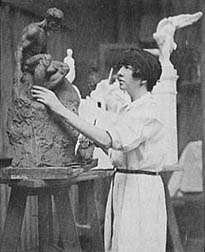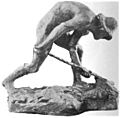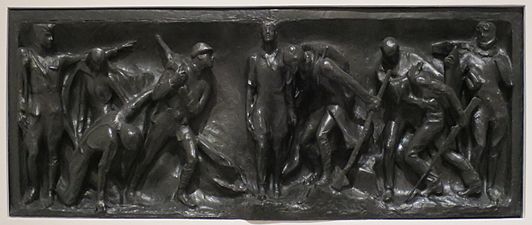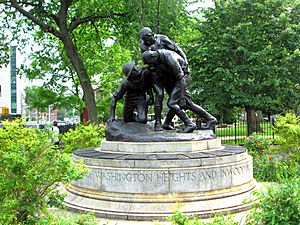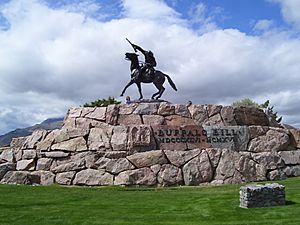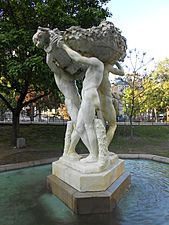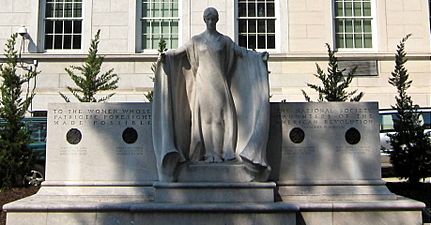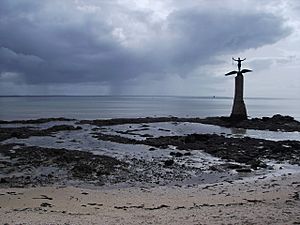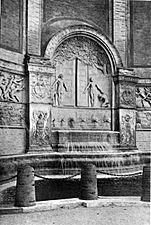Gertrude Vanderbilt Whitney facts for kids
Quick facts for kids
Gertrude Vanderbilt Whitney
|
|
|---|---|
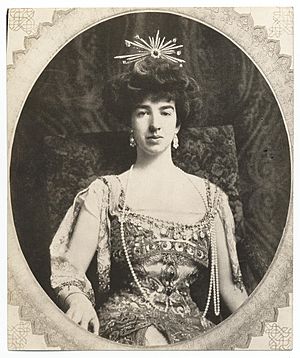
circa 1909
|
|
| Born |
Gertrude Vanderbilt
January 9, 1875 New York City, U.S.
|
| Died | April 18, 1942 (aged 67) New York City, U.S.
|
| Occupation | Sculptor Art collector |
| Spouse(s) | |
| Children | Flora Whitney Miller Cornelius Vanderbilt Whitney Barbara Whitney Headley |
| Parent(s) | Cornelius Vanderbilt II Alice Claypoole Gwynne |
| Family | Vanderbilt |
Gertrude Vanderbilt Whitney (born January 9, 1875 – died April 18, 1942) was an important American sculptor. She was also a big supporter and collector of art. In 1931, she founded the famous Whitney Museum of American Art in New York City. Gertrude came from the very rich Vanderbilt family and married into the wealthy Whitney family. She was well-known in society and often hosted events.
Contents
Early Life and Art Beginnings
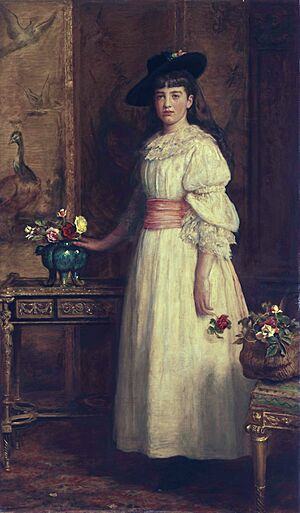
Gertrude Vanderbilt was born in New York City on January 9, 1875. She was the second daughter of Cornelius Vanderbilt II and Alice Claypoole Gwynne. Her great-grandfather was the famous "Commodore" Cornelius Vanderbilt. Gertrude grew up with several brothers and a younger sister.
Her family lived in a huge, fancy house in New York City. In the summers, they stayed at their summer home, The Breakers, in Newport, Rhode Island. Gertrude was educated at home by private teachers and also went to the special Brearley School in New York City. From a young age, she showed interest in art by keeping small drawings and watercolor paintings in her journals.
Learning and First Artworks
In the early 1900s, Gertrude traveled to Europe. There, she discovered the exciting art scenes in Montmartre and Montparnasse in France. This experience inspired her to become a sculptor.
She studied art at the Art Students League of New York. Her teachers included Hendrik Christian Andersen and James Earle Fraser. In Paris, she learned from Andrew O'Connor and even got advice from the famous sculptor Auguste Rodin. Her training helped her create large, impressive sculptures. While she made many smaller pieces, she is best known for her huge public artworks.
Her first public art piece was Aspiration, a life-size plaster sculpture of a man. It was shown at the Pan-American Exposition in Buffalo, New York, in 1901.
At first, Gertrude used a different name for her art. She worried that people wouldn't take her work seriously because she was a rich socialite. Her family and even her husband didn't fully support her dream of being a serious artist. She felt that if she were a man, her art would be respected more. She also felt stuck because if she took paid jobs, people said she was taking work from poorer artists. But if she didn't get paid, they blamed her for making art less valuable.
In 1907, Gertrude opened an art studio in Greenwich Village, New York. She also had a studio in Passy, a stylish area in Paris.
By 1910, she started showing her art publicly under her own name. Her statue Paganisme Immortel was displayed in 1910. Spanish Peasant was accepted at the Paris Salon in 1911. Her Aztec Fountain won a bronze medal in 1915 at an exhibition in San Francisco. Her first solo art show was in New York City in 1916.
World War I and Later Sculptures
During World War I, Gertrude Whitney spent a lot of her time and money helping others. She set up and ran a hospital for wounded soldiers in Juilly, France, which is near Paris.
While at the hospital, Gertrude drew the soldiers. These drawings later became ideas for her war memorials in New York City. Before the war, her art style was less realistic. But after seeing the war, she changed her style to make her work feel more serious.
She created many smaller sculptures that showed soldiers realistically during wartime. While these smaller works weren't seen as very important when she was alive, art experts now admire their detailed craftsmanship.
Besides group shows, Whitney had many solo exhibitions. These included a show of her wartime sculptures in New York in 1919, a show at the Art Institute of Chicago in 1923, and another in New York City in 1936. Most of her works from this time were made in her Paris studio. After she passed away, the Whitney Museum of American Art held a special show of her works in 1943.
Sculptures from her 1936 Show
Public Artworks
After World War I, Gertrude Whitney also created many sculptures to remember important events. In the 1920s, her large sculptures were praised in both Europe and the United States. Later, in the 1930s, big sculptures became less popular. Whitney's last public art pieces were Spirit of Flight for the 1939 New York World's Fair, and the Peter Stuyvesant Monument in New York City.
Here are some of Gertrude Vanderbilt Whitney's many artworks in the United States:
- Aztec Fountain – Pan American Union Building, Washington, D.C., 1912
- Fountain of El Dorado – 1915 Panama-Pacific Exposition, San Francisco, California
- Two reliefs on the Victory Arch – Madison Square, New York City, 1918–19
- Washington Heights-Inwood War Memorial – Mitchell Square Park, Washington Heights, New York City, 1922
- Buffalo Bill - The Scout, William F. Cody Memorial – Cody, Wyoming, 1924
- Untermyer Memorial, Woodlawn Cemetery, New York City, 1925
- The Founders of the Daughters of the American Revolution – Constitution Hall, Washington, D.C., 1929
- Titanic Memorial – Washington, D.C., 1931
- Peter Stuyvesant Monument, New York City, 1936–1939
- To the Morrow, also called Wings or Spirit of Flight, for the World's Fair in New York, 1939
-
Washington Heights-Inwood War Memorial (World War I), New York City
-
Titanic Memorial, Washington, D.C.
-
Buffalo Bill - The Scout, Cody, Wyoming
-
The Three Graces, McGill University, Montreal, Quebec, Canada
-
A.E.F. Memorial, Saint-Nazaire, France
Many art critics believe Whitney's Titanic Memorial is her most important artistic work. She won $50,000 in a competition in 1914 to build this statue.
Whitney also created art for other countries. This includes the A.E.F. Memorial in St. Nazaire Harbor in Saint-Nazaire, France, from 1924. The French government bought a copy of the head from the Titanic memorial, which is now in the Musée du Luxembourg museum.
She sculpted the Christopher Columbus memorial, called "Monumento a la Fe Descubridora" (Monument to the Discovery Faith), in Huelva, Spain. This large work, created between 1928 and 1933, has a cubist style.
In 1931, Whitney gave the Caryatid Fountain to McGill University in Montreal, Quebec, Canada. This fountain is also known by several other names, including The Three Graces. A bronze copy of this fountain is also in Washington Square in Lima, Peru.
Supporting the Arts
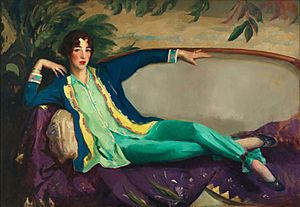

Gertrude's great wealth allowed her to become a patron of the arts. This means she used her money to support artists and art. She worked hard to help women artists, making sure their work was shown in special women-only exhibitions and in mixed shows. She also supported art shows locally and across the country, including the important 1913 Armory Show in New York.
Whitney also gave money to the Society of Independent Artists, started in 1917. This group helped artists who wanted to try new styles, different from traditional art schools. She bought many artworks from new artists, including those from the Ashcan School. In 1922, she paid for The Arts magazine to keep it from closing. She was also the main financial supporter for the "International Composer's Guild," which promoted modern music.
By 1908, Whitney had opened the Whitney Studio Gallery in the same buildings as her own studio. Artists like Robert Henri and Jo Davidson showed their work there. In 1914, Gertrude also started the Whitney Studio Club. This was a place where young artists could meet, talk, and show their art. She even helped many of them find places to live and gave them money for living costs. The Whitney Studio Club grew and moved to a bigger location in 1923. These early galleries eventually became her most famous legacy: the Whitney Museum of American Art.
In 1929, Whitney offered to give her collection of nearly 700 American modern art works to the Metropolitan Museum of Art in New York. She also offered to pay for a new building wing to hold them. However, the Metropolitan Museum turned down her offer because they didn't want to collect American art at that time. So, in 1931, Whitney decided to create her own museum. She renovated and expanded one of her studios to do this. She chose Juliana R. Force, her assistant since 1914, to be the museum's first director. The new museum aimed to celebrate modern American art.
Her Greenwich Village studio has been recognized as a National Treasure. This means it's an important historic landmark.
When Whitney passed away in 1942, she left $2.5 million to the Whitney Museum of American Art. This helped the museum pay off its debts.
Personal Life
At age 21, on August 25, 1896, Gertrude married the very wealthy sportsman Harry Payne Whitney. Harry was a banker and investor. He inherited a large fortune from oil, tobacco, and banking. In New York, the couple lived in fancy townhouses. They also had a country estate on Long Island. Gertrude and Harry Whitney had three children:
- Flora Payne Whitney (1897–1986)
- Cornelius Vanderbilt Whitney (1899–1992)
- Barbara Whitney (1903–1983)
Harry Whitney died in 1930 at age 58. Gertrude Whitney died on April 18, 1942, at age 67, due to a heart condition. She was buried next to her husband in Woodlawn Cemetery in The Bronx, New York City. Her daughter, Flora Whitney Miller, took over her mother's role as the head of the Whitney Museum. Flora's daughter, Flora Miller Biddle, later took on this role.
Awards and Honors
- Medal of Award at Panama-Pacific Exhibition for Fountain of El Dorado, 1915
- Associate member of National Sculpture Society, 1916
- Medal from the New York Society of Architects for the Mitchel Square World War I memorial, 1923
- Honorary degree, New York University, 1922
- Honorary degree, Tufts University, 1924
- Bronze medallion at Paris Salon for Buffalo Bill – The Scout, 1924
- French Legion of Honor medal, 1926
- Honorary degree, Rutgers University, 1934
- Elected an honorary member of the American Institute of Architects, 1934
- Honorary degree, Russell Sage College, 1940
- Associate of National Academy of Design, 1940
- Medal of Honor of the National Sculpture Society, 1940
Images for kids
See also
 In Spanish: Gertrude Vanderbilt Whitney para niños
In Spanish: Gertrude Vanderbilt Whitney para niños


